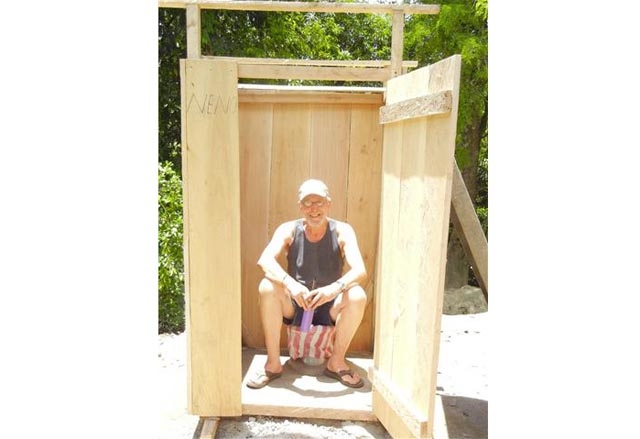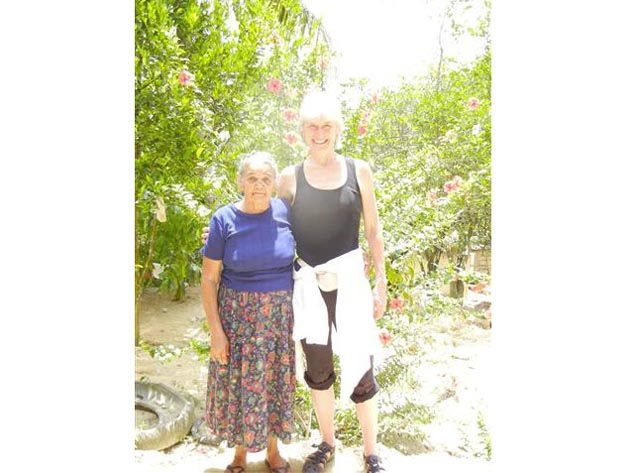2011 Honduras Trip

On this page:
Trip Participants
The Service Project
Trip Chronology
Honduran Flora and Fauna
Neno’s Las Mangas family
Trip Participants’ Photos
Trip Participants
- Byerly-Duke, Eli
- Byerly-Duke, Jacob
- Byerly-Duke, Kyna
- Byerly-Duke, Rachel
- Duke, Jeremy
- Gassmann, Allie
- Gassmann, Gabriel
- Gassmann, Leila
- Gassmann, Walter
- French, Aiyana
- French, Cassie
- French, Dan
- Holmes, Peter
- Mize, Robert
- Patton, Marty
- Ratermann, Evan
- Ratermann, Graham
- Ratermann, Tom
- Schillinger, Mary Beth
- Tanski-French, Caya
- Tanski, Rachel
The Service Project
Our project was building latrines for an extended family in the hills of Las Mangas. About 50% of Hondurans live in rural areas, and 75% live in poverty, according to Heifer International. Our UU congregation has a strong interest in economic justice, particularly in the economic context for some of the northward emigration from Central America to the U.S.
Friends at the United Church of Christ in Columbia, MO, had personal ties with a Honduran named Cito, the individual who became our project foreman. Cito is the one who recommended a community (Neno’s extended family in the hills of Las Mangas) and a service project (helping to build 10 latrines). Neno’s extended family resides in about ten mud casas with thatched roofs, wood-fired ovens, no electricity, and limited clean water in the Rio Cangrejal valley in the beautiful Pico Bonito national forest.
We had much to teach each other. We learned much from them about resourcefulness, self-sufficiency, and sustainability.
Trip Chronology
June 6 – flew from Kansas City, MO, to San Pedro Sula, Honduras; took bus from SPS to La Ceiba on the north coast
June 7 – traveled by bus from La Ceiba to Las Mangas, met Neno & family, & started work on latrines
June 8, 9, 10 and 11 – worked on latrines, lunched with familiesJune 12 – snorkeled in Cayos Cochinos
June 13 – took bus from La Ceiba to San Pedro Sula; flew from San Pedro Sula, Honduras, to Kansas City, MO.
—————
Lunes – June 6
Our bus trip from San Pedro Sula to La Ceiba was harrowing and awesome, past pineapple and palm plantations and lush, mist-topped mountains. Romulo gunned the bus past trucks, cyclists, & mopeds, past lots of brightly painted homes, some with corrugated iron roofs, some deserted or only half-built with rebar sticking up, some with litter, roosters, or bony horses, tethered or loose. Beautiful flowering bushes were mixed in with scraps along the roadside.
We stopped for a late lunch at a buffet catering to tourists and then packed back into the bus, shoulder to shoulder, window to window. Scenery was awesome and sobering. One of the suitcases full of soccer shorts exploded before arriving at the Gran Hotel Paris in La Ceiba. Most of us took a swim before a special supper served for us. Allie Gassmann, our fearless leader, provided an overview of the week and closed with a Native American reading. At check-in, many expressed gratitude for the participation of our UU kids.



Martes – June 7
Once we were up the Congrejal valley in Las Mangas, Alexis fed us a second breakfast and Cito met us at the gate. We walked down the steep path to the river, forded it on foot or by raft, and climbed a steep path on the other side. Local children scampered about like mountain goats. Stunning beauty: Heavily forested, mist-topped mountains towered above.
There awaiting us were about a dozen thatch-covered stucco casas, each with a 6×6-foot dug waiting for a latrine. Cito showed the group how to place rocks, mix cement, and place rebar and corrugated tin over the hole. Friendships were forged with host families.
After breaking at one, we forded the river and returned to the one-lane Las Mangas, where roosters and chickens meandered freely with bicycles, mopeds, an occasional bus, and lots of people on foot. A soccer game might be in full throttle, a tethered monkey might be pulling a dog’s tail at the casa across the road, and hibiscus and other beautiful flowering bushes spilled over walls and gateways. Occasional loud music and lots of beeps from passing buses filled the air as our UU kids played basketball. Supper was six-ish, almost dark.



Miércoles – June 8th
Alexis served us cereal, milk, and mangoes with thick strong coffee and good juices, as usual.
We forded the stream again and returned to our families. Juan Carlos Lopeti had already boxed in his stoop for the latrine. Watching both Juan and Rosabelle handle a machete was a marvel – he turned a blunt log into a pencil sharp spike in nothing flat. Their kindergartner, Diana, could mix & shovel cement like a 16 year old boy.
Rosabelle allowed Marty into her cocina and showed her how to chop papas on the washing/cutting board hanging out the window. She also showed Marty how to pat tortillas and throw them on the wood-fired stove top.
Many groups placed their toilets on the cement pads – against a magnificent forested mountain background.
Friendships among young and old continued to blossom. Hondurans and Americans alike did their best with learning a new language – with the help of several bilingual speakers in the group.
Trees around the mountain village include bananas, mangoes, pineapple, lemon, apricot, and more.
Later we took an awesome hike to a waterfall. Most of us took a dip. Some of us tried Wendy’s yoga class after supper in the Guaruma meeting room.
Jueves – June 9
Before getting up, we heard intense rain drilling on the tin roof, dogs barking and music from the hotel across the road, but day dawned and we breakfasted on tortillas, eggs, beans, cheese, fruit, good juice, and strong thick coffee.
Off again, we went down the steep, stony path, across the river, and up to work – many of us moving frequently from site to site. During the day, UU kids stirred up lots of games with Honduran kids – Uno, ball games, and more. Peter, the Pied Piper of Las Mangas, entertained all with balloons & his recorder. Marty picked up trash and a half dozen little boys jumped into the action – like an Easter egg hunt for them and Halloween for her, watching her bag fill.
Later we meandered up the lane to part of the Pico Bonito forest on the other side of the bridge, where local Guaruma graduates introduced us to Ceiba trees you could hide in, fig trees that blossom at night with bark like elephant skin, huge palm trees, and trees with bark too smooth for snakes.
The climax of the tour was a hike over a newly repaired swing bridge to another awesome waterfall and swimming hole. Brave ones jumped from rock tops; others held their breath and hoped everyone cleared the stone.
Viernes – June 10
Back in Neno’s village, we saw Quaker State Oil water jugs hanging from porch posts, a bolt-lock stainless steel doorknob on a shed with a rusty corrugated tin top, and freshly swept dirt yards. One 60-pound octogenarian making her way up the steep incline from the river stopped to kiss us, bubbled over enthusiastically in Spanish, and hobbled away, using her machete as a cane.
The forest village was an interesting combination of medieval and post-modern culture: Some casas were sparsely furnished (hammock, one table, three plastic chairs, clay wood-fired oven) with no electricity or running water – but the residents had cell phones.
Mid-afternoon Cito trucked several loads of us up to his mother’s sewing co-op in El Pital, accessible only via a wire cable over the Cangrejal. There we bought goods from the co-op and hiked to still another magical swimming hole. There was a precipitous drop down to the water, and many of us swung like monkeys from a vine and dropped into the water. The lush green forest was punctuated with brilliant flowering bushes including azaleas as large as baby trees. Hibiscus petals dotted the path like confetti.
An evening hearing was scheduled for a Lobo-backed plan to build a dam upriver for hydroelectric power, which would virtually destroy downstream villages like Las Mangas. We didn’t attend, though, choosing instead to hear Neno and a brother-in-law play their guitars for us.
Sábado – June 11
After saying farewell to Neno’s group, we packed and boarded a bus headed for La Ceiba via Pepe’s place on the Cangrejal. There we said goodbye to the Byerly-Dukes.
Back in La Ceiba, we had baleadas at Romulo’s mother’s. Marty stepped out of the courtyard straight into a hole in the sidewalk. Then we headed back to the Gran Hotel Paris.
Domingo June 12
By 7:30 a.m. most of us were congregated in the lobby of the Gran Hotel Paris, awaiting the van taking us to Sambo Creek, a Garifuna village near La Ceiba with a Pentacostal or other evangelical church wedged in between every other structure.
At Tourismoptions.com, we boarded a boat and headed out into the Cayos Cochinos islands, not far from the Bay Islands, to go snorkeling in the world’s second largest coral reef. We enjoyed snorkeling, traipsing through the rainforest in search of a pink boa constrictor (found! Leila can tell you!), eating Garifuna food (tapdados), and being chased back to shore by high waves.
Our captain, Xavier, superbly surfed the waves for almost an hour, gunning the motor then cutting it, riding a wave, waiting for the bob of the next really big one, and gunning it as the next wave crested. Waves got bigger and bigger, but Xavier was masterful – a Garifunian who allegedly learned to swim before he could walk.
An Italian film crew allegedly was filming a reality show on one island.
Once back in La Ceiba, we ate at an ex-pat sports bar, and many of our group watched the NBA playoffs.
Honduran Flora and Fauna
Neno’s Las Mangas Family
Below are some photos of our dozen-plus host family members.
Trip Participants’ Photos
Trip participants are shown in the following photo slideshow:
Top of Page






















































